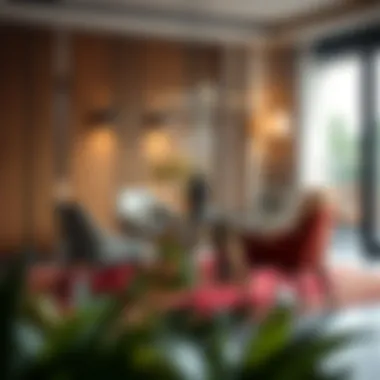Exploring Modern Formal Dining Sets in Design


Intro
In the world of interior design, few areas reflect personal style and sophistication like the dining room. Modern formal dining sets are not merely functional pieces of furniture; they are reflections of taste, elegance, and even status. This exploration will dive into the allure of these dining sets by examining their styles, the materials involved, and how they meld elegance with practicality. Whether you’re a designer piecing together a luxurious dining space or a homeowner searching for the perfect blend of aesthetic and functionality, understanding the principles behind modern formal dining sets is essential.
These sets serve as focal points within dining environments, capable of transforming a simple meal into an occasion. In this article, we will uncover the various furniture design styles that dominate modern dining sets, offer practical tips for both purchasing and maintaining these pieces, and suggest ways to help you create a dining space that harmonizes perfectly with your home’s character. Let’s begin our journey into the realm of modern dining sets and their significant role in home decor.
Furniture Design Styles
Overview of Popular Styles
When it comes to dining sets, the design styles are as diverse as the tastes of those choosing them. Some popular styles include:
- Mid-Century Modern: Characterized by clean lines, organic shapes, and a perfect balance of form and function, these sets evoke a sense of nostalgia while remaining contemporary.
- Scandinavian: Known for its minimalism and functionality, Scandinavian design often features light woods and simple yet striking forms that invite warmth and comfort into the dining space.
- Industrial: With its raw materials like metal and reclaimed wood, industrial sets add an urban edge to any setting. The combination of sleek metal with rustic elements creates a unique dining atmosphere.
- Transitional: Merging traditional elegance with modern flair, transitional dining sets utilize classic shapes and materials, yet infuse them with contemporary aesthetics to appeal to varied tastes.
These styles don’t just operate in isolation; they can coexist beautifully, allowing homeowners to tailor their spaces more closely to their personal aesthetic.
How to Mix and Match Styles
Mixing styles can appear daunting, but with an eye for balance, it can create a uniquely appealing dining environment. Start by choosing a dominant style and then incorporate elements from another. For example, a rustic farmhouse table can look stunning paired with sleek, modern chairs. Here are some tips:
- Stick to a Color Palette: When combining different styles, adhere to a cohesive color scheme. This helps to tie disparate pieces together.
- Scale Matters: Ensure that the sizes of your chosen pieces complement each other. A large table might overpower delicate chairs, while petite tables can make larger seats seem clunky.
- Use Accessories Wisely: Integrate decor that reflects both styles. Think of centerpieces or table settings that harmonize the designs together, enhancing each other's aesthetic.
When mixing styles, the goal is to ensure that they work together seamlessly, creating a space that feels both cohesive and dynamic.
Practical Tips for Homeowners
Essential Buying Tips
When it comes to purchasing a modern formal dining set, several considerations will guide you in making the right decision:
- Assess Your Space: Measure your dining area accurately. This indicates where you can comfortably place the dining set, preventing overcrowding.
- Materials Matter: Select materials based on durability, ease of care, and style preferences. Hardwoods like oak or walnut withstands wear, while synthetic materials can offer modern aesthetic without breaking the bank.
- Style Alignment: Ensure the set aligns with the overall design language of your home. A chic modern dining set won’t look quite right in a heavily traditional setting.
Maintenance and Care Guidelines
To keep your dining set looking its best, consider the following maintenance tips:
- Regular Cleaning: Maintain cleanliness by dusting and wiping down surfaces with appropriate cleaners that suit the materials used.
- Protective Measures: Use coasters, placemats, and tablecloths to protect surfaces from scratches and stains.
- Follow Manufacturer’s Instructions: Always adhere to any specific cleaning and care recommendations provided with the set, ensuring longevity and sustained visual appeal.
A little care goes a long way in ensuring that your modern formal dining set continues to serve as a centerpiece for many meals and gatherings.
Dining tables often become the heart of a home, a place where not just meals but memories are made. Choosing the right set can elevate these moments into treasured traditions.
By embracing the nuances of style and practicality in your choices, modern formal dining sets can easily serve as both functional pieces and artistic statements within any dining space. The right blend of materials, styles, and thoughtful maintenance can create a dining experience that resonates for years to come.
Understanding Modern Formal Dining Sets
The realm of modern formal dining sets has significantly evolved and transformed over the years. Today, these sets stand as more than just furniture; they are now vital components of interior design that marry aesthetics with functionality. Understanding modern formal dining sets can guide homeowners and designers in selecting pieces that not only enhance a space but also reflect personal style and taste.
When defining modern formal dining sets, it is essential to consider their role in today's living environments. They are often the centerpiece for social gatherings, family meals, and celebrations, making their selection an important decision. A well-chosen dining set can elevate the dining experience, making it more enjoyable and inviting.
In essence, the importance of understanding modern formal dining sets lies in:
- Aesthetic Value: These sets contribute to the overall decor while providing a canvas for creative expression.
- Space Efficiency: An understanding of your dining space can help choose a set that maximizes comfort and mobility.
- Material Selection: Knowledge of various materials and their durability can lead to better investment choices. This ensures that your dining set stays functional and visually appealing for years.
The modern dining set landscape includes various styles, materials, and features. Pinpointing your preference can guide not just your purchase but also how you arrange your dining area. In the following sections, we will delve deeper into specific components of modern dining sets, including material choices, design elements, and their functional aspects, ensuring a well-rounded grasp for designers, retailers, and homeowners alike.
Defining Modern Formal Dining
Defining what modern formal dining entails means looking beyond mere furniture arrangement. It encompasses aspects of design principles, lifestyle integration, and usability. Generally, a modern formal dining set typically includes a table paired with an array of seating options, like chairs or benches, all crafted with an emphasis on clean lines and minimal ornamentation.
When one thinks of modern formality, styles from around the globe influence the definition, bringing a tangible richness to the spectrum. Sets may vary from Scandinavian minimalism with light woods and straightforward designs to exuberant industrial styles featuring raw metals and reclaimed materials. This variety allows homeowners to choose a look that resonates with their style and the overall ambiance of the home.
A modern formal dining set also focuses on functionality, seamlessly blending into the household while appearing stylish. Many modern sets prioritize ergonomic designs, ensuring durability and ease of use, which is crucial for everyday living.
Historical Context and Evolution
The evolution of dining sets has been a fascinating journey. Historically, dining tables were often large, communal structures built from heavy woods, a nod to their practicality and significance in social engagement. As societies shifted and lifestyles changed, so too did dining sets.
In the early 20th century, designs began to reflect the changing social dynamics of family and dining customs. It was during this time that the rise of modern design movements, such as Bauhaus, shaped not only the practicality of dining sets but also their form and aesthetic. Fast forward to today, and we see a strong influence of both historical context and contemporary needs. Modern dining sets embody versatility: they must accommodate different lifestyles while maintaining elegance.


- The 1970s saw a mix of materials and colors, which highlighted individuality yet also obscured cohesiveness.
- In the 1980s and 1990s, the focus shifted towards more classic and robust designs, favoring functionality without sacrificing aesthetics.
- Now, the ongoing trend towards sustainable materials and silhouettes draws on the simplicity and clarity admired in modern design.
This historical trajectory illustrates that today’s modern formal dining sets are products of layered influences. Each piece tells a story, influenced by cultural shifts, lifestyle changes, and evolving design philosophies. Understanding this history not only enriches the appreciation of dining sets but also enhances the choices available for contemporary dining spaces.
Key Features of Modern Dining Sets
Modern formal dining sets embody a blend of functionality and aesthetic appeal, making them crucial components in today’s dining areas. Their characteristics often reflect the occupant's tastes and lifestyle, serving as focal points in both casual and formal settings. As more people invest in their living spaces, understanding the features that define modern dining sets becomes essential. By focusing on material choices, design elements, and overall durability, one can make informed decisions that enhance both everyday dining experiences and special gatherings.
Material Choices and Durability
The materials used in modern dining sets are vital, impacting not only the look but also the longevity of the furniture. Options like solid wood, metal, glass, and composite materials offer varying levels of durability and maintenance needs.
- Solid wood dining sets, often made from oak or walnut, bring warmth and timelessness. Their longevity can be attributed to their robust nature, but they require more upkeep to maintain their finish.
- Metal options, like stainless steel, provide a sleek aesthetic that can withstand wear and tear without visibly deteriorating. They’re less prone to scratching, which is beneficial for families with kids.
- Glass tops can lend an airy feeling to a room but might not be the best choice for households with energetic pets or children, as they can chip or crack from rough treatment.
- Composite materials, combining various substances, often provide durability at a lower price point, making them appealing for those looking to balance budget and resilience.
Design Elements and Aesthetic Appeal
Shapes and Sizes
Shapes and sizes of dining sets play a significant role in maximizing space and boosting functionality. Round tables can foster a sense of intimacy and encourage conversation, making them an ideal choice for smaller gatherings. On the other hand, rectangular tables can cater to larger families or entertaining occasions, providing ample room for dishes and decor.
Some key characteristics of the shapes include:
- Versatility: Many modern dining sets come in different shapes, allowing for flexible arrangements in various spaces.
- Scale: Selecting the right size is crucial; too large a table can overwhelm a small dining room, while a too-small one can feel out of place in a spacious area.
- Extensibility: Some designs come with extendable options, providing flexibility for special occasions without committing to a larger, permanent piece.
When considering shapes, it’s essential to visualize how these designs will fit within your existing space and complement the overall decor.
Color Palettes
Color choices in modern dining sets can set the mood and coordinate with the home’s theme. A neutral base, such as white or grey, offers a versatile backdrop, allowing other decor options to shine. Bold colors, like deep greens or blues, can make a striking statement.
The benefits of particular color palettes include:
- Compatibility: Choosing colors that match or complement your existing decor helps in creating a harmonious environment.
- Mood Influence: Colors can influence the atmosphere; softer tones create calmness while brighter shades can invigorate the space.
- Trends: Choosing trendy colors can keep the dining area feeling contemporary, although it’s wise to balance this with timeless options to avoid frequent replacements.
Finishing Techniques
Finishes can enhance the visual appeal and usability of dining sets. From matte to glossy, each finish has its own character and care requirements.
- Matte finishes offer a more understated look, often perceived as modern and smooth but may show scratches more easily.
- Glossy finishes can make wood grain pop and are easier to clean, although they may require continual polishing to maintain their sheen.
- Distressed finishes bring a vintage charm, pairing well with rustic decor, but might not suit all tastes.
The unique features of finishing techniques can significantly influence decisions about dining sets. A well-chosen finish can enhance the aesthetic, imparting sophistication and style to any dining room.
"The beauty of a dining set truly lies in its ability to bring together family and friends, creating memories around the table that last a lifetime."
In summary, understanding these key features of modern dining sets provides essential insights for homeowners and designers alike. By carefully considering material choices, design elements, color palettes, and finishing techniques, one can choose a dining set that not only complements the home but stands the test of time.
Styles of Modern Dining Sets
Understanding the various styles of modern dining sets is essential because it not only highlights the aesthetic appeal but also reflects the personal taste and functionality desired in a dining space. Each style carries with it a unique charm and set of characteristics that can either complement or revolutionize the existing decor. Knowing these styles helps homeowners, designers, and decorators to make informed decisions when selecting dining sets that marry form and function effectively.
Contemporary Minimalism
Contemporary minimalism is all about less being more. It embraces simplicity and clean lines, focusing on the essence of the furniture rather than ornate details. This style is characterized by:
- Neutral Color Schemes: Often utilizing whites, blacks, and grays, with occasional pops of color to accentuate the setting.
- Functional Forms: Straight edges and bold shapes that proclaim functionality without frills.
- Open Spaces: Furniture arrangement aims to create a feeling of spaciousness.
Minimalist dining sets typically use materials such as metal and glass, reflecting light and creating an inviting environment. This style is perfect for urban dwellers who thrive on sleek, uncluttered spaces.
Scandinavian Influences
Rooted in the Nordic countries, Scandinavian design emphasizes simplicity, utility, and beauty. It merges traditional craftsmanship with modern design. Key characteristics include:
- Warmth and Texture: Light woods, wool, and textiles create a cozy atmosphere in dining spaces.
- Functionality: Each piece is designed to serve a purpose; versatile pieces often can serve multiple functions.
- Natural Light: Designs often seek to maximize natural light, reflecting the long, dark Nordic winters.
Scandinavian dining sets typically showcase clean lines, an array of soft pastels, or bright whites, making them suitable for various interior decors. They offer a friendly, inviting atmosphere, perfect for casual gatherings.
Industrial Aesthetics
Industrial design brings a raw, urban feel to dining spaces. Originating from converted warehouses and factories, this style features materials in their natural state. Its hallmarks include:
- Raw Materials: Think reclaimed wood, metal, and concrete that bring an edgy feel to the dining area.
- Asymmetry and Bold Structures: Industrial sets often flaunt unique, sometimes awkward shapes that create visual interest.
- Exposed Elements: Pipes or vents are left visible as part of the design, adding to the character of the space.


An industrial dining set can become a statement piece itself, evoking a sense of history while providing a mechanism for modern dining experiences.
Mid-Century Modern
Mid-century modern is a style that exudes retro charm, characterized by its classic lines and playful colors. Originating in the mid-20th century, it emphasizes functionality and simplicity with a touch of whimsy. Notable features include:
- Organic Shapes: Chair designs often feature curves and rounded edges that encourage comfort and ease.
- Bold Colors: Bright hues combined with warm woods breathe life into a dining space, shifting moods effortlessly.
- Iconic Materials: Many mid-century dining sets include plastic, laminates, and molded forms, adding to their uniqueness.
Overall, mid-century modern dining sets offer nostalgia and character, catering to those who appreciate design history while craving a modern twist.
In summary, knowing the different styles of modern dining sets enables designers and homeowners alike to choose pieces that not only fit their aesthetic sensibilities but also enhance their dining experience. By understanding each style, one can create an environment that is both visually appealing and functionally effective.
Functional Aspects of Modern Dining Sets
In today's fast-paced world, the dining set is not just a place for meals; it’s a fundamental element that combines practicality with style. Understanding the functional aspects of modern dining sets allows homeowners and designers to create inviting spaces that cater not only to aesthetic preferences but also to daily needs. Whether hosting a dinner party or enjoying a quiet meal, how a dining set functions can significantly impact the overall experience.
Space Optimization
When considering space optimization, modern dining sets can transform an ordinary dining area into an efficient, multifunctional hub. Many designers are now focused on how these sets can fit seamlessly within various room dimensions. For instance, tables that can extend during gatherings or compact designs for smaller spaces have become increasingly popular.
- Extendable Tables: These can accommodate both intimate dinners and larger groups. When not in use, they can compact easily, freeing up space for other activities.
- Stackable Chairs: Many stylish sets now include chairs designed to be stacked when not in use, which keeps the space tidy and organized. This is especially handy for homes with limited square footage.
- Multipurpose Furniture: Some dining sets incorporate storage solutions, like benches with hidden compartments or tables with shelving underneath. This provides functionality without sacrificing style.
- Arranging for Flow: The layout should promote good flow within the room, allowing guests to move around comfortably. Positioning the table away from walls can create an open atmosphere that feels inviting.
By incorporating these elements, homeowners can make the most out of their dining areas, ensuring both style and function are in perfect harmony.
Comfort and Accessibility
Comfort in a dining space can greatly enhance the overall meal experience. It's paramount that each piece within a dining set contributes to an inviting atmosphere. This extends beyond just comfortable seating; it also involves accessibility for all users, from children to the elderly.
- Chair Design: The right chair can truly make all the difference. Ergonomically designed seats invite longer gatherings without discomfort. Styles such as those with adequate lumbar support or soft cushioning are favored for this reason.
- Table Height: Standard table heights often cater to an average adult, but consider varying needs. Taller or shorter tables may also be desirable in environments catering to specific populations.
- Adequate Space: Each place at the table should allow for personal space. At least 24 inches of width often provides the room needed for diners not to feel cramped, promoting a more relaxed dining experience.
- Universal Design: With a growing emphasis on accessibility, dining sets that accommodate wheelchairs and other mobility aids become essential in many homes. A wider tabletop and sufficient legroom can genuinely enhance usability.
As we rethink modern dining sets, it's crucial to prioritize comfort and accessibility as key components. When diners feel at ease, meals tend to last longer, conversations flow more freely, and the space becomes a place of connection and enjoyment.
"A dining set is more than furniture; it’s where memories are crafted, and connections are made."
Current Trends in Dining Set Design
In the realm of interior design, dining sets have morphed from mere functional furniture into expressions of personal taste and lifestyle. The trends shaping modern dining sets encapsulate a mix of aesthetic appeal and practical concerns, and providing an intimate backdrop for gatherings. Today’s design era emphasizes both beauty and sustainability, appealing to a wide range of consumers who value quality and environmental consciousness in their purchases.
Sustainable Materials and Practices
As the world becomes increasingly aware of ecological issues, the need for sustainable materials in furniture extends to dining sets as well. Utilizing resources like reclaimed wood, bamboo, and recycled metals not only contributes to a reduced carbon footprint but also presents unique visuals that differentiate dining sets in the market.
- Reclaimed Wood: This choice carries a story, providing character that new materials often lack. Each piece displays its own history, from the imperfections of old barn wood to the smooth finishes of recycled hardwood.
- Bamboo: This grass grows quickly and requires minimal resources, making it an eco-friendly alternative that's also durable. Its sleek appearance great for adding a modern touch without sacrificing environmental responsibility.
- Adhesives and Finishes: Many manufacturers are now leaning towards non-toxic adhesives and low-VOC finishes. This not only ensures a safer home environment but also aligns with current health-conscious trends.
Investing in sustainable dining sets can be a significant conversation starter, showcasing a buyer's commitment to ethical consumerism.
"Sustainability is not just a trend; it's about making choices today that lead to a better tomorrow."
Customization and Personalization
In recent years, the emphasis on customization has surged, with homeowners no longer content with off-the-shelf solutions. They seek dining sets that reflect their personal style and meet their specific needs. This trend leads toward a more intimate dining experience while giving designers and retailers unique opportunities to engage with their clients.
Designers are now offering:
- Modular Designs: These are versatile and can be adapted based on space and usage, which is ideal for smaller homes or apartments. Customers can easily add or remove pieces depending on their needs.
- Choice of Materials: Allowing buyers to choose the finish and material of their dining sets offers a way for them to express their tastes. Whether someone prefers a warm wood tone or a bold metal finish, having options enhances satisfaction.
- Personalized Accents: Items like engraved nameplates or custom cushion covers make the tables feel unique to the owner. This fulfills a human desire for individuality and ownership.
Ultimately, these customization opportunities not only provide a tailored dining solution, but they also contribute to the narrative of a home, weaving personal stories into everyday life.
For more insights on sustainable practices in design, visit Wikipedia.
For further information on customization options within furniture design, one might find useful resources at redbit.com or Britannica.
By keeping these trends in mind, homeowners, designers, and retailers can create dining experiences that are not just visually appealing but are imbued with meaning and purpose.
Maintaining Modern Formal Dining Sets
Maintaining modern formal dining sets is crucial to ensure their longevity and aesthetic appeal. A well-cared-for dining set not only enhances the dining experience but also serves as a visual focal point in the home. Regular maintenance goes beyond simply cleaning; it involves understanding the materials used and how they interact with everyday life. This section outlines practical tips and protective measures to preserve the beauty and functionality of dining sets for years to come.
Cleaning and Care Tips
Keeping your modern formal dining set clean is essential. Dust, spills, and everyday wear can degrade the visual charm over time. Here are some essential cleaning and care tips:


- Use a Soft Cloth: Always start with a soft, lint-free cloth when cleaning. Avoid abrasive materials that could scratch the surface.
- Mild Detergent: Use a mixture of mild soap and water for deeper cleaning. For wooden surfaces, ensure to use cleaners specifically formulated for wood.
- Avoid Harsh Chemicals: Strong chemicals can wear down finishes and ruin the material. Stick to gentle cleaners to maintain the integrity of your dining set.
- Regular Dusting: Dust accumulation can dull the shine of your dining table. A weekly dusting routine will ensure it remains pristine.
- Address Spills Promptly: Any spills should be addressed immediately. Blot the spill with a clean cloth and avoid rubbing it to prevent spreading.
"Taking a few minutes to clean after each use can prevent deeper cleanings that could risk damaging your dining set."
Protective Measures
To further protect your dining set from wear and tear, consider the following measures:
- Table Protectors: Invest in high-quality table covers or placemats made from cloth or silicone. These will safeguard the surface against scratches and heat damage.
- Coasters and Utensils: Use coasters to prevent water rings and heat marks from beverages and dishes. Similarly, using utensils that are gentle on your table, such as wood or silicone, can help maintain the finish.
- Avoid Direct Sunlight: Ultraviolet rays can cause materials to fade over time. Position your dining set away from direct sunlight or use window treatments to minimize exposure.
- Temperature Control: Extreme temperature changes can lead to warping, especially in wooden dining sets. Maintain a stable climate in your dining area to avoid such issues.
By following these care tips and protective measures, homeowners can significantly extend the life and beauty of their modern formal dining sets. Regular attention to cleaning and protection is key to ensuring that these focal points of the dining experience remain both functional and visually appealing.
Choosing the Right Dining Set
Choosing the right dining set is not just about picking out a stylish table and some chairs; it’s about curating the very essence of your dining experience. A dining set serves as the centerpiece for numerous family gatherings, dinners with friends, and special occasions. Hence, understanding your options and the factors influencing your choice can make a substantial difference in how you engage with your dining space.
When selecting a dining set, several critical considerations come into play: size, function, style, and of course, your unique preferences. It can determine comfort, aesthetics, and even the flow of the space. Paying attention to these elements can enhance not just the look of your dining area but also the experiences shared around the table.
Assessing Your Space
Before diving headfirst into the world of dining sets, take some time to assess your available space. Measure your dining area meticulously, making sure to account for the following:
- Room Dimensions: Note the length and width of the area to understand what size of table will fit comfortably.
- Traffic Flow: Ensure there’s enough room for people to move around without feeling cramped. Ideally, leaving around 36 inches of clearance around the table allows for easy access.
- Shape Consideration: Depending on your room shape, you might opt for round, square, or rectangular tables. Round tables can be great for smaller spaces, while rectangular ones often fit larger settings better.
Aside from measurements, consider how you typically use your dining area, as this will inform your choice even further. If you frequently host large gatherings, perhaps a extendable dining table would suit your needs. Conversely, a smaller setting might benefit from a more intimate table that encourages conversation.
Matching with Existing Decor
Once you've evaluated your space, the next step is to ensure that your dining set complements your existing décor. Cohesiveness in style not only enhances the visual appeal but also creates harmony in your living environment. Here are some points to ponder:
- Design Style: Whether your décor leans towards modern, rustic, or eclectic, your dining set should echo that style. For instance, a sleek, minimalist dining set pairs well with modern aesthetics, while a reclaimed wood table might suit a farmhouse vibe better.
- Color Scheme: Consider the color palette of your current décor. If your living area boasts bold colors, a neutral-toned dining set might balance the space. Alternatively, a pop of color can act as a statement piece amid softer tones.
- Material Harmony: Look at the materials in your home. If you have wooden floors and wooden furniture, a dining set crafted from a similar wood can create a nice tie-in. Metals can offer a pleasing contrast when done mindfully.
As you choose your dining set, bear in mind that your selection doesn't just fill a need for furniture; it should also tell your personal story and reflect your taste.
"A dining table is not just a place to eat. It is a place for connections and memories created with those we cherish."
In summary, making an informed decision when choosing your dining set can elevate your dining experience. Take the time to carefully assess your space and match your selected set with your existing decor, ultimately creating an inviting atmosphere suitable for both everyday meals and special gatherings.
The Role of Dining Sets in Social Gatherings
Dining sets are more than mere furniture; they are the heart of our social interactions, especially in a home environment. This section examines how modern formal dining sets play a crucial role in fostering connection, conversation, and memorable experiences.
Creating a space conducive to sharing meals can significantly elevate the quality of gatherings. When family and friends gather around a well-crafted dining set, it encourages a sense of togetherness, transforming any meal into a shared occasion rather than a hurried bite. The design and functionality of dining sets enhance this atmosphere tremendously, making them essential components in any gathering.
Creating an Inviting Atmosphere
The aesthetics of a dining set have the power to sway the mood of diners. A thoughtfully chosen table, paired with complementary chairs and decor, can make even the simplest meal feel like a celebration. The right balance of styles, from rustic charm to sleek modernity, speaks volumes about personal taste and can instantly create an inviting ambiance.
- Material Matters: Wooden tables impart warmth, while metal or glass options can evoke a more contemporary feel.
- Color Coordination: Hues like deep greens or rich blues can invite a feeling of elegance, while lighter colors foster a relaxed atmosphere.
- Table Settings: Beautiful tableware paired with well-thought-out centerpieces can elevate the dining experience, signaling that this meal is significant.
For instance, during a family reunion, a long, wooden table adorned with seasonal flowers and personal touches can set an inviting tone, encouraging guests to linger and connect. A well-kept table can be the canvas for numerous evenings filled with stories, laughter, and celebration.
Enhancing Dining Experiences
The dining set also plays a host in how meals are experienced. Comfort and functionality can enhance dining interactions, creating space for intimacy or lively engagement. The right seating can provide a balance of comfort and support, vital for longer meals where conversations flow freely.
- Ergonomics: Chairs that are supportive and appropriately cushioned make it easier for guests to relax, enjoy their food, and engage in community.
- Space for Sharing: A well-sized table promotes interaction; it allows for plates to easily move around without feeling cramped.
- Versatility: Adapting a dining set's formality according to occasion can enhance experiences. A set that allows for easy transition from casual breakfast to elegant dinner caters to varied gatherings.
In essence, modern formal dining sets are about creating a centerpiece for life’s important moments. The right choice allows for hosting everything from intimate dinners to elaborate feasts, molding the dining experience into something truly memorable. As you consider your space, think beyond just furniture—recognize the potential that exists for fostering connection and joy through thoughtful dining set selection.
"A dining table isn't just a piece of furniture; it's a gathering spot for our lives. Each meal shared signifies more than eating—it’s about connection."
For more insights on dining spaces and effectively enhancing your home, consider exploring resources like Wikipedia or Design Milk.
The End
In wrapping up our exploration of modern formal dining sets, it's clear these pieces are more than just furniture; they act as the backbone of social interactions and family gatherings. A well-chosen dining set can dictate the atmosphere of a room, providing a space that encourages conversation and connection.
The Future of Formal Dining
The future of formal dining sets seems poised for significant transformation, driven by evolving preferences and societal shifts. Here are some considerations for what's next:
- Sustainable Practices: Many consumers are leaning toward sustainability. From eco-friendly materials to ethically sourced wood, the push for greener choices is reshaping how dining sets are crafted. Companies are exploring new methods to lessen their environmental impact while maintaining style and durability.
- Multi-functionality: As living spaces become increasingly compact, the demand for versatile dining sets will grow. Sets that serve multiple purposes or come with customizable components are likely to be in high demand. Imagine a table that can expand for gatherings yet fit snugly in a small apartment during the week.
- Technology Integration: Future dining sets may not just be about the materials but also about smart technology. Tables with built-in charging pads or lighting features that can adapt to different moods are becoming feasible. These advancements boost convenience while marrying form with function.
- Diverse Aesthetic Choices: With globalization, the aesthetic influences surrounding dining set designs will continue to increase. Expect to see a blend of styles that reflect various cultural designs, portraying uniqueness and individual expression.
"A dining set doesn't just serve meals but creates memories. It reflects who we are and how we connect with those around us."
All these factors contribute to how we perceive and use our dining spaces, leading us to profound choices not merely based on need but on the essence of our lifestyles. As trends evolve, designers and homeowners alike must adapt to create environments that are not only pleasing to the eye but also resonate with personal values and communal experiences.















